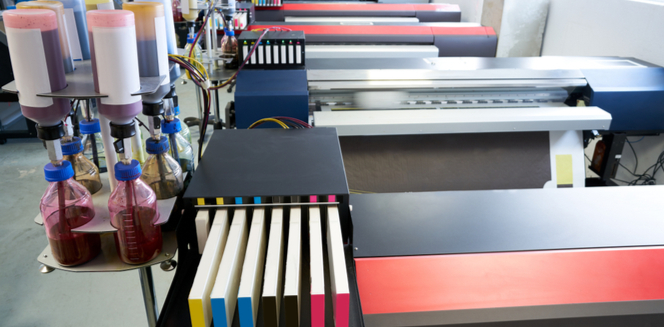Know Different Types, Advantages, And Future Of Digital Textile Printing Inks

14 Aug
2020
The textile industry has always been searching for new ways to enhance the quality and designs that appeal to customers. To make decent quality apparel, manufacturers need good designers, advanced digital printers, and more importantly, high-quality inks which are simple to print and less harmful to the environment and customers. Thus, over the last few years, the apparel industry has been investing in R&D to launch new pigment inks.
According to Allied Market Research, the digital textile printing inks market is expected to reach $2.66 billion by 2027, growing at a CAGR of 11.6% from 2020 to 2027. This is because of increasing demand for 3D printing and developments in digital printing. Although the demand for textile inks has increased over, there is still ignorance regarding types, and pros and cons of use of different types of textile printing inks.
Prime types of digital textile printing inks
- Reactive inks
These inks are widely used in the textile industry, especially for digital textile printers. These inks are used to print on cotton, silk, and wool. The key benefits of using reactive inks for digital printing is its ability to offer the high-quality of colors along with high wash fastness. The best results are reached after using reactive inks on cotton as the use of reactive inks on wool or silk may seem less faded and less intense. However, if you consider high wash fastness more important, the use of reactive inks is beneficial.
- Acid inks
Acid inks are used in need of vibrant colors and preferred to print on textiles that do not hold color easily. Thus, acid inks are widely accepted for printing on silk and wool. With acid inks, one can get color brilliance, and thus, they are often used for printing swimwear as acid inks show high tolerance to saltwater and chlorine.
- Disperse inks
Dispersed inks widely used to print on polyester fabrics. This ink is directly sprayed on the fabric after which it is steamed and washed. These processes allow the ink to completely penetrate the fabric and properly lock onto the textile. This process is essential to print colors with high wash fastness and high color brilliance. Although disperse inks have been used for conventional printing, now they are being used on polyester in the fashion industry. The only disadvantage of the use of disperse inks is they are not compatible with high-speed printers.
- Pigment inks
Almost half of all fabrics are printed using pigment inks and customers demand pigment inks for digital printing as it enables textile printing at a lower price with acceptable color. However, for acceptable color yield, pre-treatment is essential, which makes the printing process more complicated as the pigment particles must be very small to go through the inkjet head. In addition, this process to make smaller particles is expensive than instant reactive inks.
Last year, the market leader in textile industry, DuPont has launched new pigment inks that are suitable for roll-to-roll printing. The launched inks were said to be of medium viscosity and offers excellent color saturation along with wet & dry crock fastness and soft texture.
- Sublimation inks
With the increasing popularity of digital textile printing, the demand for new types of printing inks such as sublimation inks has increased. Sublimination fabric printing involves printing the ink onto a paper and then put this printed paper with fabric under high pressure and temperature so that the ink can change from liquid to gas. This gas can penetrate the polyester fibers and the colors can get easily locked into the textile once the pressure and temperature are lowered. The prime advantage of sublimation inks that you don’t need to wash and steam the fabric after printing. Moreover, sublimation inks are less damaging to the environment and more affordable than conventional printing methods. Thus, it is most suitable for digital textile printing.
The increasing awareness regarding sustainability and eco-friendly product, people now are more focused on using textile inks that are less harmful to the environment. What’s more, the textile and fashion industry has already adopted several sustainable manufacturing processes. Thus, the future of digital textile printing inks would be in formulating eco-friendly inks and making the textile printing more eco-friendly.

Koyel Ghosh
Author’s Bio- Koyel Ghosh is a blogger with a strong passion and enjoys writing in miscellaneous domains, as she believes it lets her explore a wide variety of niches. She has an innate interest in creativity and enjoys experimenting with different writing styles. A writer who never stops imagining, she has been serving the corporate industry for the last five years.
Avenue: Entire Library membership of Allied Market Research Reports at your disposal
- Avenue is an innovative subscription-based online report database.
- Avail an online access to the entire library of syndicated reports on more than 2,000 niche industries and company profiles on more than 12,000 firms across 11 domains.
- A cost-effective model tailored for entrepreneurs, investors, and students & researchers at universities.
- Request customizations, suggest new reports, and avail analyst support as per your requirements.
- Get an access to the library of reports at any time from any device and anywhere.
Related Post
-
How are Submarine Cables Transforming Global Connectivity with Enhanced User Experience?
-
Endoscopy Procedures: Transformations in Techniques and Applications
-
AI-Powered Video Analytics: How the Product Actually Works for enterprises
-
Painting Robots: Transforming Precision Coating and Creative Applications
-
Innovations in Pharmacovigilance Systems Advancing Patient Safety
-
Understanding Edge Security: Keeping Data Safe Near the Source
-
Exploring the Use and Advancements of 3D Laser Scanners in Professional Applications
-
Reinforcing Industrial Controls with Smarter Tools and Training








